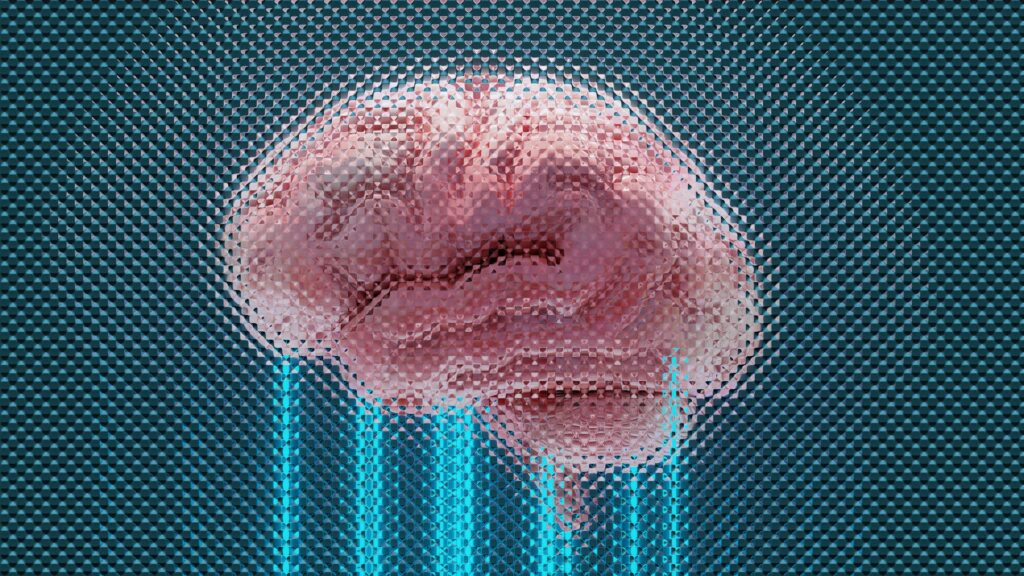Thinking through the nature of evil, a young Augustine found himself wrestling with the relationship between physics, which he called “corporeal things,” and the mind. His account of this struggle, recorded in his immortal work, Confessions, ironically describes what contemporary materialists experience daily: “I turned my attention to the nature of the mind, but the false opinions which I entertained of spiritual things prevented me from seeing the truth.”[1]
Not so with neurosurgeon Dr. Michael Egnor, who sees the truth about the mind with great clarity: Our bodies consist of physics, but our minds belong to the soul, which is spiritual in nature. Dr. Egnor is a distinguished professor of neurosurgery and pediatric neurology at State University of New York at Stony Brook, and his book The Immortal Mind brings his vast knowledge of the brain to the question of the mind/body problem, arguing, along with co-author Denyse O’Leary, that the evidence from brain science clearly demonstrates that humans have non-corporeal spiritual souls and that the mind is not the same as the brain.
Questioning Materialism
This was not always the case with Dr. Egnor. He started out as an atheist, growing up in a family that was only loosely religious. He always loved science, believing that it provides objective answers about the world. He dreamed of exploring the mysteries of the world using the scientific method and its dispassionate collection of data and thoughtful contemplation to answer some of our greatest questions.
When Egnor made it to medical school, he adopted the dominant view of Western science, namely, that of monistic physicalism (or materialism). Materialism posits that there is only one kind of existence in the universe: the physical. Thus, physics can explain everything and religion is a myth. Egnor was not an angry atheist; he was just following the dominant view of science. But an astonishing conversion experience changed his view in a singular moment.
“An astonishing conversion experience changed his view in a singular moment.”
After his son was born, the boy seemed unable to make eye contact and did not respond to others. As he was a six-month-old baby, it was too early to say, but the family already feared that he had autism. Dr. Egnor was crushed and found himself unable to think of anything else as he went about his day. One day as he was leaving a patient visit at a Catholic hospital across town, he passed its chapel. In that moment, he made the fateful decision to go inside the chapel and to lay down his burden. Inside, Dr. Egnor offered a prayer to the God, whose existed he doubted.
“God,” he said, “I don’t know if you exist, but I need help. I am terrified that my son is autistic. It’s agony to have a child who will never know or love me.” Suddenly he heard a voice—the only time he’s ever heard one like it. The voice responded to him: “But that’s what you’re doing to Me.”
Dr. Egnor fell to the ground, continued his prayer, and the next morning he called a priest and asked to be baptized. Egnor’s materialism collapsed when he discovered that God was real.
Egnor’s conversion was surprising, but not as much as it might appear. He had already started to be haunted by the fact that he would sometimes see, among his patients, mental abilities that seemed unconnected to what brain science would have predicted. His scientific training had taught him that there must be a natural explanation for these phenomena, but he was starting to doubt.
“His scientific training had taught him that there must be a natural explanation for these phenomena, but he was starting to doubt.”
After years of practicing medicine, including more than 7,000 brain operations, Dr. Egnor is now a convinced dualist: the mind belongs to the soul even though the brain belongs to physics. This argument is classically Christian, and Dr. Egnor frequently cites Aquinas to define the soul. Dr. Egnor, however, does not approach the subject primarily from a religious or even philosophical point of view. Rather, he looks at the question as a brain scientist. He offers clear evidence that the mind cannot be reduced to a mere function of the brain but that it belongs to the soul and is spiritual in nature. Aquinas had defended dualism philosophically. Egnor does so scientifically.
Distinguishing Mind from Brain
This makes Egnor’s book The Immortal Mind extremely helpful for the believer, since one should expect the basic claims of the Christian faith to withstand scrutiny. The book is unashamedly Christian.
But the book is more than an apologetic; it also provides insight into how the mind might function and why the whole question matters.
Reading Dr. Egnor’s book is a great pleasure, for the book is filled with concrete examples of how the mind appears to possess a different constitution from anything that the brain could generate. His arguments are sensible and persuasive, and he illustrates them from his own practice as well as from the work of other scientists.
One of his first arguments has to do with corpus callosotomy—the procedure of deliberately splitting the brain at its two hemispheres—a procedure sometimes performed in extreme cases of epilepsy. If the mind were a mere function of the brain, Dr. Egnor notes, one would expect that a patient whose brain had been split would generate two minds, since, after all, the procedure of corpus callosotomy produces something close to two brains in one person. But, rather strangely, patients of this procedure often experience virtually no changes in their lives—other than relieving epilepsy symptoms. And they certainly do not suddenly acquire two minds, which one would predict if the mind were only a function of the brain. Rather, the mind remains unified, evidence of its spiritual constitution.
“The mind remains unified, evidence of its spiritual constitution.”
Dr. Egnor also explores the concept of what the ancients would call “higher thinking”, which Aristotle called the “nous” (from the Greek for “mind”), and which Egnor calls “abstract thought”. The matter is complex, but to simplify it, first think of seeing three nickels added to two other nickels, which might be called “concrete thought”. Now consider the principle that three plus two always equals five, which is an “abstract thought”. Brain scientists are able to stimulate the concrete areas of the brain: by manipulating the brain, they can stimulate movements of the body, memories, and emotions. But they cannot stimulate reason, free will, or abstract thought. Egnor takes this to mean that abstract thought is a function of the mind, and that it is qualitatively different from the brain. Abstract thought cannot be measured in the brain. It is non-material. It belongs to the soul.
Stories That Defy Materialism
The stories in the book are fascinating. Egnor tells of patients who are vegetatively comatose, but whose brain patterns indicate that they are somehow “conscious”, which should be impossible if the mind were a mere function of the brain. Studies in this area are hard to do, since nobody voluntarily undergoes a coma for observation. Nevertheless, tests have been conducted on comatose patients with strange results that show the mind still active even when the brain is not.
One test in particular is downright mind-boggling. A male patient with brain damage who had been comatose for two years was subject to a test using an advanced MRI, which measured activity in his brain. The attending physicians, Adrian Owen, Steven Laureys, and others, instructed the comatose patient to think of playing a tennis match or of walking across a room—two activities that light up different parts of the brain. (Keep in mind they had no evidence that he could hear them or even think at all.) The researchers then told the comatose patient to think of the tennis match if he meant “yes” and think of walking across the house if he meant “no”. Amazingly, when the researchers asked the patient six questions about his family, he answered all six correctly in his mind! Such results, Egnor explains, defy materialist explanations and suggest that the mind is more than mere brain matter.
“Such results, Egnor explains, defy materialist explanations and suggest that the mind is more than mere brain matter.”
Egnor explores many other phenomena that demonstrate an ontological difference between the mind and the brain. Near death experiences (NDEs) offer such compelling evidence that even skeptics struggle to explain it. Some of the most compelling are NDEs in which braindead patients “see” things that are impossible for them to see physically, such as things in the operating room. Strangely, even blind patients see things! In one NDE, a patient saw a relative dead and “in heaven” even though neither he nor his attending family members knew that the person had died just a couple days before. And NDEs tend to lead to changes in the lives of patients who experience them. Many commit to living more virtuous lives, find new purpose, and experience newfound joys. Such NDE’s suggest that some part of us transcends our bodies with our minds and are, as his title claims, immortal.
Dualism and Free Will
Defining consciousness and even the mind can be notoriously difficult, and when it comes to definitions, Egnor helpfully draws from several sources. He is fond of Aquinas, who suggests that the mind has three powers: movement, sensation, and rationality—a categorization which Aquinas got from Aristotle. He also references Thomas Nagel’s well-known definition of consciousness—consciousness is “what it’s like to be something.” For Egnor, the existence of these nonphysical realities suggests that we are essentially dualistic beings: we are both matter and spirit.
In making his case for the soul, Nagel must address the dominant position of much of the sciences—material determinism. Determinism is the view—the rather necessary view for those who deny the spiritual—that everything that happens had to happen, because literally everything is just a result of a chain reaction set in motion by the Big Bang. There is no mind. There is no free will. There are only chemicals in motion. To paraphrase the nineteenth century determinist Pierre-Simon de Laplace, if we could measure where everything in the universe had been in the past and could measure where everything is today, we would know without a doubt where everything will be for the rest of time—right down to which cheese I have in tomorrow’s charcuterie.
“He is fond of Aquinas who suggests that the mind has three powers: movement, sensation, and rationality.”
This is the position that materialists have to take, and to introduce free will into the equation is to violate naturalism. So, technically speaking, stricter versions of today’s science cannot admit to free will, good or evil, choice, and the like. Dr. Egnor offers a scathing critic of such ridiculous determinism. Every single day, even determinists live as though we have free will. We reward virtuous behavior and punish evil conduct. We make decisions, think abstract thoughts, and exercise consciousness, none of which can be reduced to determinism. Determinism is the empty conclusion of materialism that literally nobody practices.
As a subset of determinism, Dr. Egnor also addresses behaviorism, made popular in the U.S. by B. F. Skinner. Behaviorism has largely been discredited by the sophistication of such things as human grammar, a la such thinkers as Noam Chomsky, but its assumptions persist. Behaviorism, Egnor argues, fails in the same way that general determinism fails.
Animals, Artificial Intelligence, and Us
Dr. Egnor also takes on Darwinism, which, because of its inability to be tested, he calls “atrocious science”. Darwinism is the only science that’s measurement free, he explains, which makes it less a science and more just a bunch of stories. Darwinism offers stories to try to explain the mind; such things as the mind were necessary for humans to hunt—even when other animals hunt perfectly well without our sophisticated minds. He points out that “there is no DNA for abstract human thought, for reason and free will,”[2] and demonstrates that Darwinism simply cannot account for abstract thought. For this we need the soul.
But what about artificial intelligence (AI)? Will computers eventually develop consciousness, awareness, or a mind? Isn’t AI becoming so sophisticated that it will eventually demonstrate that one can have a mind materialistically, without a spiritual soul? Dr. Egnor rightly argues that computers are not like brains. Computers make computations, but they do not think. Appealing to the thought experiments of John Searle, he demonstrates that a computer can arrange any number of inputs, but it will never know it is making those arrangements. It has no awareness, no common sense, no consciousness. Computers can add the numbers 43 and 13, but they will never have an awareness of what those numbers mean. Indeed, computers are the opposite of consciousness. They are blank slates upon which programmers express their consciousness. Behind any AI software are thousands of man-hours of individuals writing answers to questions. And this is why the brain is not like the computer, and computers will never have minds.
“Behind any AI software are thousands of man-hours of individuals writing answers to questions.”
Living Souls
But where is the soul to be found in the body? Egnor argues that, since the soul is spiritual, the soul has no specific place in either time or space, even as we know when it interacts with matter. It is not in the brain per se, or the heart, or in a gland.
Rather, the soul is the sum of all the powers that make us human living beings. It is in the beat of the heart, the metabolism of the cells, the action of the lungs, in the memory, in our reason, and so forth. Spirits don’t occupy a physical space; rather, they are present wherever they act. It has no parts but rather is a unified whole. And where the body sees light, the soul sees truth. “We haven’t found the material center of consciousness in the brain because the human soul isn’t in the brain. Consciousness has no location. The human soul is spiritual.”[3]
Egnor understands why knowing that we have immortal souls is important. It is important for our well-being, for our understanding of ourselves, our bodies, our families, our laws, and our culture. Understanding that our souls are immortal is reason enough to preserve the lives of humans, even those unborn. It helps us understand that “every kind act and cruel word reverberates in eternity.” And it connects us to our Maker. We are living souls. We ought to live like it.
“We are living souls. We ought to live like it.”
Evaluation of The Immortal Mind
Are there criticisms I would offer about the book? Not really. I have no basis to critique his neurological examples and conclusions; they are merely fascinating to me. His criticisms of determinism are warranted, as his skepticism of mere Darwinism is refreshing. His apologetics are brief, but good. And his understanding of the soul is consistent with Christian tradition—can you go wrong with Aquinas on this matter?
If I were to offer Dr. Egnor any questions, they would be these: how exactly does the soul interact with the brain? Where is the point of contact? By what mechanism does this happen? Dr. Egnor touches on these questions, but I would have enjoyed more. And I would also like to have heard Dr. Egnor discuss mental illness and the mind, and questions such as how drugs like LSD seem to alter the mind. But one has to stop a book somewhere.
To summarize, I find the book to be informative, exciting, and reassuring. Knowing that the faith delivered to us a couple millennia ago still resonates with people, even highly educated scientists, thrills my mind—and my soul. And having myself a grandson who is under the care of a pediatric neurosurgeon as I write this only adds to the satisfaction I find in the book. I highly recommend it.
“I find the book to be informative, exciting, and reassuring.”
Years ago, on the very next day after Dr. Egnor prayed in the hospital chapel, his son looked at his parents, smiled at them, and laughed with them, growing up a healthy boy after that. God responded to Egnor’s prayer with a miracle. But God gave Dr. Egnor more. He gave him a profound discovery. “All I have found points to one truth—we have spiritual immortal souls.”[4]
[1] Augustine, “Chapter 15: While Writing, Being Blinded by Corporeal Images, He Failed to Recognise the Spiritual Nature of God,” Confessions, Book IV, 15.24. https://www.newadvent.org/fathers/110104.htm.
[2] Egnor and O’Leary, The Immortal Mind, p. 179.
[3] Egnor and O’Leary, 167.
[4] Egnor and O’Leary, 219.











